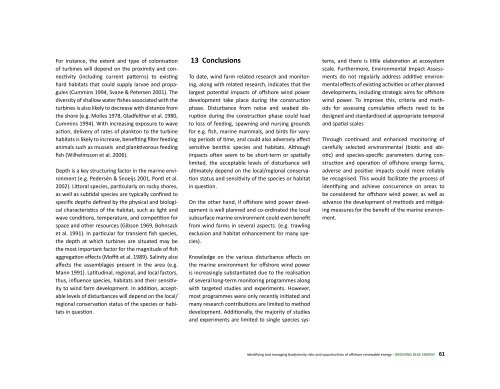Greening Blue Energy - BioTools For Business
Greening Blue Energy - BioTools For Business
Greening Blue Energy - BioTools For Business
Create successful ePaper yourself
Turn your PDF publications into a flip-book with our unique Google optimized e-Paper software.
<strong>For</strong> instance, the extent and type of colonisation<br />
of turbines will depend on the proximity and connectivity<br />
(including current patterns) to existing<br />
hard habitats that could supply larvae and propagules<br />
(Cummins 1994, Svane & Petersen 2001). The<br />
diversity of shallow water fishes associated with the<br />
turbines is also likely to decrease with distance from<br />
the shore (e.g. Molles 1978, Gladfelther et al. 1980,<br />
Cummins 1994). With increasing exposure to wave<br />
action, delivery of rates of plankton to the turbine<br />
habitats is likely to increase, benefiting filter feeding<br />
animals such as mussels and planktivorous feeding<br />
fish (Wilhelmsson et al. 2006).<br />
Depth is a key structuring factor in the marine environment<br />
(e.g. Pedersén & Snoeijs 2001, Ponti et al.<br />
2002). Littoral species, particularly on rocky shores,<br />
as well as subtidal species are typically confined to<br />
specific depths defined by the physical and biological<br />
characteristics of the habitat, such as light and<br />
wave conditions, temperature, and competition for<br />
space and other resources (Gibson 1969, Bohnsack<br />
et al. 1991). In particular for transient fish species,<br />
the depth at which turbines are situated may be<br />
the most important factor for the magnitude of fish<br />
aggregation effects (Moffit et al. 1989). Salinity also<br />
affects the assemblages present in the area (e.g.<br />
Mann 1991). Latitudinal, regional, and local factors,<br />
thus, influence species, habitats and their sensitivity<br />
to wind farm development. In addition, acceptable<br />
levels of disturbances will depend on the local/<br />
regional conservation status of the species or habitats<br />
in question.<br />
13 Conclusions<br />
To date, wind farm related research and monitoring,<br />
along with related research, indicates that the<br />
largest potential impacts of offshore wind power<br />
development take place during the construction<br />
phase. Disturbance from noise and seabed disruption<br />
during the construction phase could lead<br />
to loss of feeding, spawning and nursing grounds<br />
for e.g. fish, marine mammals, and birds for varying<br />
periods of time, and could also adversely affect<br />
sensitive benthic species and habitats. Although<br />
impacts often seem to be short-term or spatially<br />
limited, the acceptable levels of disturbance will<br />
ultimately depend on the local/regional conservation<br />
status and sensitivity of the species or habitat<br />
in question.<br />
On the other hand, if offshore wind power development<br />
is well planned and co-ordinated the local<br />
subsurface marine environment could even benefit<br />
from wind farms in several aspects. (e.g. trawling<br />
exclusion and habitat enhancement for many species).<br />
Knowledge on the various disturbance effects on<br />
the marine environment for offshore wind power<br />
is increasingly substantiated due to the realisation<br />
of several long-term monitoring programmes along<br />
with targeted studies and experiments. However,<br />
most programmes were only recently initiated and<br />
many research contributions are limited to method<br />
development. Additionally, the majority of studies<br />
and experiments are limited to single species sys-<br />
tems, and there is little elaboration at ecosystem<br />
scale. Furthermore, Environmental Impact Assessments<br />
do not regularly address additive environmental<br />
effects of existing activities or other planned<br />
developments, including strategic aims for offshore<br />
wind power. To improve this, criteria and methods<br />
for assessing cumulative effects need to be<br />
designed and standardised at appropriate temporal<br />
and spatial scales<br />
Through continued and enhanced monitoring of<br />
carefully selected environmental (biotic and abiotic)<br />
and species-specific parameters during construction<br />
and operation of offshore energy farms,<br />
adverse and positive impacts could more reliably<br />
be recognised. This would facilitate the process of<br />
identifying and achieve concurrence on areas to<br />
be considered for offshore wind power, as well as<br />
advance the development of methods and mitigating<br />
measures for the benefit of the marine environment.<br />
Identifying and managing biodiversity risks and opportunities of offshore renewable energy - GREENING BLUE ENERGY 61



